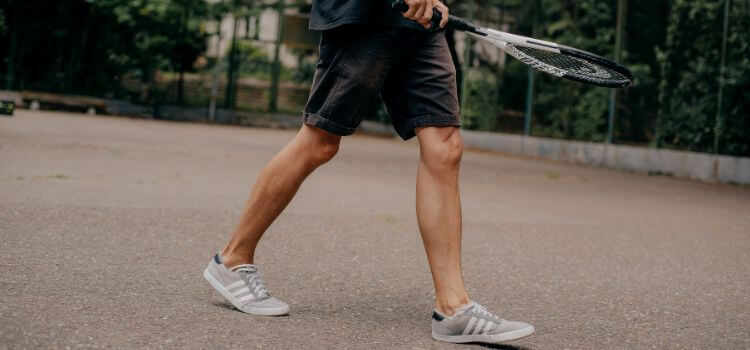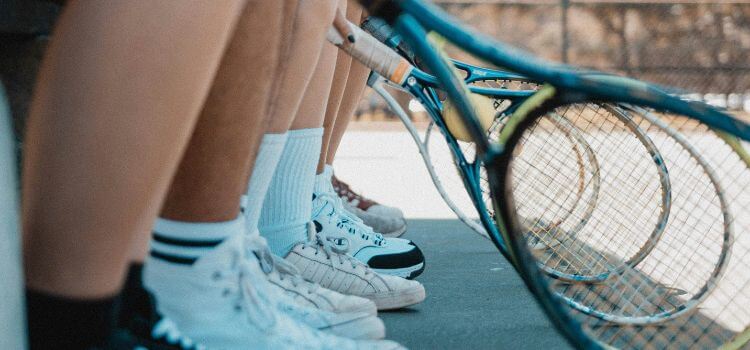As an Amazon Associate, I earn from qualifying purchases.
Running shoes are not ideal for tennis, as they’re designed for forward motion. Tennis requires footwear that supports lateral movements.
Engaging in tennis with running shoes might be tempting, especially if you already own a comfortable pair, but this could lead to injury and reduced performance on the court. Proper tennis shoes offer the necessary lateral support and have a more durable sole to withstand the quick, sideways movements and sudden stops inherent to the game.

Selecting the correct footwear is crucial for any athlete to optimize their performance and avoid potential strains or sprains. So, while your running shoes may serve you well on the track or the treadmill, investing in a dedicated pair of tennis shoes is advisable for anyone serious about their game.
The Essential Shoe Guide
Shoes are the foundation of every sports outfit. They are crucial for performance and safety. This guide explores the differences between running shoes and tennis shoes. It also highlights the key features to look for in athletic footwear. Let’s dive into the world of sports shoes!
Running Shoes Vs. Tennis Shoes
Choosing the right shoes for a sport is about more than just comfort. It is also about avoiding injuries and improving performance. Running shoes and tennis shoes serve different purposes.
| Running Shoes | Tennis Shoes |
| Designed for forward motion | Built for lateral movement |
| Have thick, soft heels | Feature more stable, flatter soles |
| Lightweight construction | Durable with reinforced sides |
Running shoes focus on absorbing shock during forward motion. Tennis shoes offer support for quick, side-to-side movements.
Critical Features Of Athletic Footwear
- Support: Shoes must support the feet during the specific sport’s movements.
- Durability: Consider materials that endure the sport’s terrain and wear.
- Fit: A proper fit is critical to ensure comfort and prevent blisters.
- Breathability: Look for materials that help manage moisture and heat.
- Cushioning: Heel and forefoot cushioning absorb impact, reducing stress on the body.
- Traction: Outsoles should provide a grip specific to the sports surface.
Remember, the right shoe enhances performance and reduces injury risk. Always select shoes that match sport-specific demands.
Risks Of Improper Footwear
The Risks of Improper Footwear cannot be overstated, especially in sports like tennis, where agility, stability, and precise footwork are critical. Selecting the correct type of shoes is vital for both safety and performance. Running shoes may not be the best choice for the tennis court, and here’s why.

Injury Prone With The Wrong Shoes
Choosing to wear running shoes for tennis can lead to an increased risk of injuries. The lateral movements and stops in tennis require shoes with a specific design for side-to-side motion. Running shoes typically provide forward motion support, potentially leading to:
- Ankle rolls and sprains
- Knee stress
- Toe injuries
Adequate cushioning and stability are crucial to avoid these injuries; tennis-specific shoes are designed to provide this protection.
Impact On Performance And Comfort
Not only does incorrect footwear increase injury risk, but it also substantially impacts gameplay and comfort. Running shoes lack the necessary features that optimize a tennis player’s performance, such as:
| Feature | Running Shoes | Tennis Shoes |
| Support | Primarily forward | Multi-directional |
| Sole Durability | Designed for linear wear | Adapted for court surfaces |
| Cushioning | Focus on heel-to-toe | Evenly distributed |
Players may experience discomfort and decreased performance due to the lack of adequate lateral support and sole construction that tennis shoes offer.
Anatomy Of A Tennis Shoe
Understanding the anatomy of a tennis shoe is crucial for anyone stepping onto the court. Unlike running shoes, these are built to handle the fast-paced action of tennis. Let’s dive into the unique features that set tennis shoes apart, focusing on design for lateral support, sole Durability, and tread patterns
Design Elements For Lateral Support
Tennis involves a lot of side-to-side movements. That’s why tennis shoes have particular design elements. These features stop your feet from sliding during a game. Look for these when choosing your next pair:
- Wider Bases: Offer stability during quick lateral shifts.
- Reinforced Side Walls: Provide extra support for your ankles.
- Strategically Placed Cushioning: Helps absorb impact from rapid movements.
Sole Durability And Tread Patterns
A durable sole is the signature of a tennis shoe. These soles last through many matches. Good tread patterns improve grip on the court. They let you change direction quickly without slipping. Key aspects include:

| Material | Benefits |
| Rubber Sole | Long-lasting, resistant to wear |
| Modified Herringbone Pattern | Optimal grip on different court surfaces |
When To Choose Running Shoes
Are you exploring the idea of swapping your tennis shoes for running sneakers? The decision to pick running shoes hinges on specific scenarios. Consider the activity and surface before making the switch. Not all shoe types fit every sport, so knowing when to choose the appropriate footwear is critical.
Appropriate Scenarios For Running Footwear
Running shoes shine in certain situations. Here’s where they excel:
- Jogging on tracks or trails.
- Walking long distances.
- Performing high-impact workouts.
- Everyday casual wear for comfort.
Benefits Of Running Shoes In Their Element
| Feature | Benefit |
| Cushioning | Absorbs impact and protects joints. |
| Heel Support | Stabilizes the foot and reduces injury risk. |
| Flexibility | Adapts to varied movements and improves comfort. |
| Breathability | Keeps feet cool and reduces moisture. |
Transitioning To The Court
You love to run, and now you’ve decided to try tennis.
Your running shoes have been great allies on the track, but will they serve you just as well on the tennis court?
This section is all about transitioning to the court with the proper footwear.
Adjustments For Tennis Movements
Tennis requires quick, lateral movements, unlike the forward motion in running.

- Ankle support is crucial for sudden changes in direction.
- Running shoes are designed for forward movement and may not support your ankles adequately during tennis.
- Consider shoes with a sturdier, broader base for stability.
Selecting Shoes For Different Court Surfaces
| Court Surface | Suggested Shoe Type |
| Clay | Shoes with a herringbone pattern for better grip. |
| Grass | Shoes with nubs for traction, preventing slips. |
| Rugged | Durable soles to withstand rough surfaces. |
Each tennis court type affects play differently.
Select shoes that match the surface to avoid injuries and improve your game.
Expert Advice On Athletic Shoes
Choosing the proper footwear can impact your performance in any sport. Tennis and running involve different movements, demanding specific shoe features. Expert advice can steer you towards the appropriate choice. Let’s dive into what professionals say about using running shoes for tennis.

Tennis coaches emphasize lateral support and sole Durability. Running shoes need to be higher in these areas. They suggest looking for the following:
- Tennis-specific shoes with reinforced side support
- Exclusive patterns designed for court surfaces
- Shoes that offer adequate cushioning for quick movements
| Feature | Running Shoes | Tennis Shoes |
| Support | Heel and forward movement | Lateral and ankle support |
| Sole Durability | Designed for long distances | Thicker for court action |
Tennis requires quick, multi-directional footwork. Running in tennis shoes can lead to injuries.
Podiatrists stress the importance of using the right shoe for the right sport. They highlight:
- Running shoes may increase the risk of ankle roll in tennis
- Tennis shoes provide better stability on the court
- Foot type and surface impact on foot health
Therefore, running shoes are not recommended for tennis. They lack necessary features like:
- Side-to-side support
- Adequate tread pattern for grip
- Durable outsole for court surfaces
Frequently Asked Questions For Can I Use Running Shoes For The Tennis
Running shoes are not typically recommended for tennis due to their design. They provide forward motion support, whereas tennis requires lateral support for frequent side-to-side movements.
Tennis shoes are built for lateral support and have a flatter sole for stability on the court. Running shoes focus on forward motion cushioning and heel support, which may not suffice for tennis movements.
Yes, using improper shoes, such as running shoes for tennis, can negatively affect performance. It may lead to a lack of support, increased injury risk, and decreased court traction.
Select shoes specifically designed for tennis that offer good lateral support, a durable outsole, and a stable fit. Consider the court surface and your playing style when choosing.
Conclusion
Wrapping up and opting for proper tennis shoes over running ones is wise for any player. It ensures safety and enhances performance on the court. Embrace the right gear for the right sport, and let each game be your best yet.
Remember, specific shoes cater to particular needs – choose wisely for peak play.
Amazon and the Amazon logo are trademarks of Amazon.com, Inc, or its affiliates.